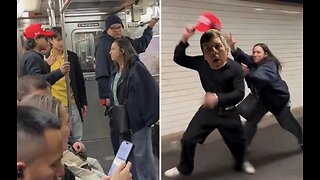Premium Only Content

序破急 jyo-ha-kyuu.【追儺9】
Generally, the term "jyo-ha-kyu" is
in Noh, Gagaku, Haikai and other performing arts in Japan.
It is used in Noh, Gagaku, Haikai, and other performing arts to refer to the rhythm and rapidity of the performance.
However, even in the martial art of iai, which is performed with a sword, a degree of slowness and rapidity seems to exist.
In other words, in the case of "nuki-hazime"
The person who draws the sword does so slowly.
This is called "序jyo" (beginning).
The one who begins to draw gradually increases the speed of the sword, and the one who begins to draw gradually increases the speed of the sword, and the one who begins to draw gradually increases the speed of the sword
breaking the stillness, "破(ha)".
The sword gains speed and
When the sword violently "nuki-tsuke" (slays the enemy), it is "急kyuu" (rapid).
In general, a nuki-tsuki is aimed at the enemy's face (temple).
The reaction of the opponent to this is
How does the opponent dodge?
Or, does he or she dodge?
That is what I depicted in this video.
In iai
the more enemies you face, the more important it is to know that
It is not only a "technique" to swing down the sword,
It is necessary to change your posture flexibly.
It seems that in each school of iaido, such stances can be learned.
However, this story is before the establishment of iaido, so the postures and the names of the techniques may be different.
The modern iaido is a YouTube video of the iaido.
In modern iai, even if you watch youtube videos
It seems that in modern iai, it is forbidden to face an opponent and use a sword face to face.
It seems that the form of practice and matches are done alone.
Also, there is a saying in Japan,
"The merit of a sword that is not pulled out
(nukanu-tatino-koumyou 抜かぬ太刀の功名)"
This means that the first thing to do is to discuss and settle the problem peacefully, and the sword is not to be pulled out.
It is said that it is best to win without drawing the sword.
-
 1:03:13
1:03:13
BonginoReport
4 hours agoGen Z Men: The Most Based Demo in America - Early Edition With Evita (Ep.166) - 03/24/2025
114K99 -
 UPCOMING
UPCOMING
The Big Mig™
4 hours agoOperation, “Let Them Speak”
2393 -
 UPCOMING
UPCOMING
LFA TV
20 hours agoTAKING OUT THE TRASH! | LIVE FROM AMERICA 3.24.25 11AM
2.74K -
 UPCOMING
UPCOMING
Caleb Hammer
9 minutes agoFinancial Audit’s Most Evil Guest
-
![🔴[LIVE TRADING] Welcome To PUMP CITY!!! || The MK Show](https://1a-1791.com/video/fww1/70/s8/1/w/o/Q/v/woQvy.0kob-small-The-MK-Show-Mar.-24th.jpg) LIVE
LIVE
Matt Kohrs
11 hours ago🔴[LIVE TRADING] Welcome To PUMP CITY!!! || The MK Show
1,545 watching -
 LIVE
LIVE
Wendy Bell Radio
6 hours agoThe Same Old Song & Dance
9,826 watching -
 1:37:50
1:37:50
Dear America
16 hours agoAOC/Bernie 2028? + Snow White BOMBS & Wrestling Crowd Goes WILD For Trump!
45.9K10 -
 1:37:52
1:37:52
Jeff Ahern
2 hours ago $0.51 earnedMonday Madness with Jeff Ahern
9.97K -
 1:15:20
1:15:20
JULIE GREEN MINISTRIES
4 hours agoLIVE WITH JULIE
144K254 -
 1:30:46
1:30:46
Game On!
15 hours ago $3.80 earnedIt's March and we were promised MADNESS!
46.5K1